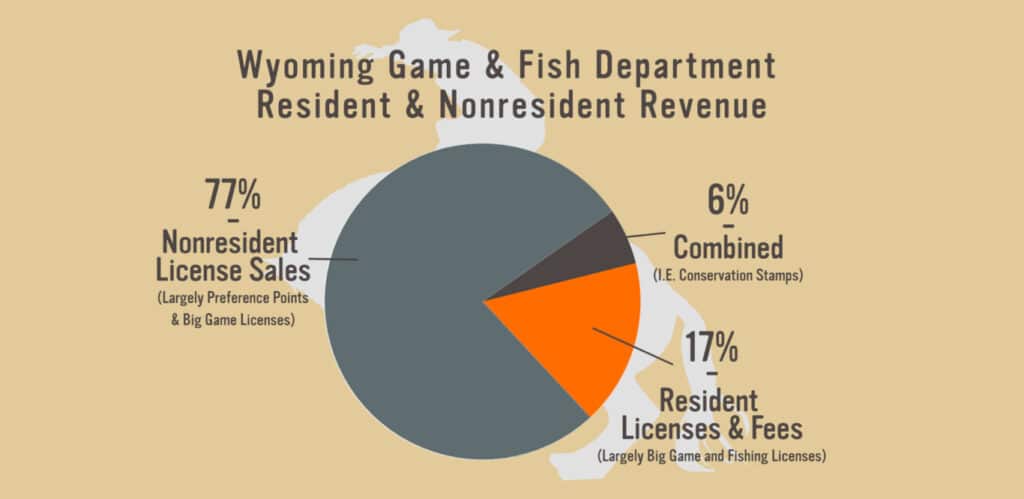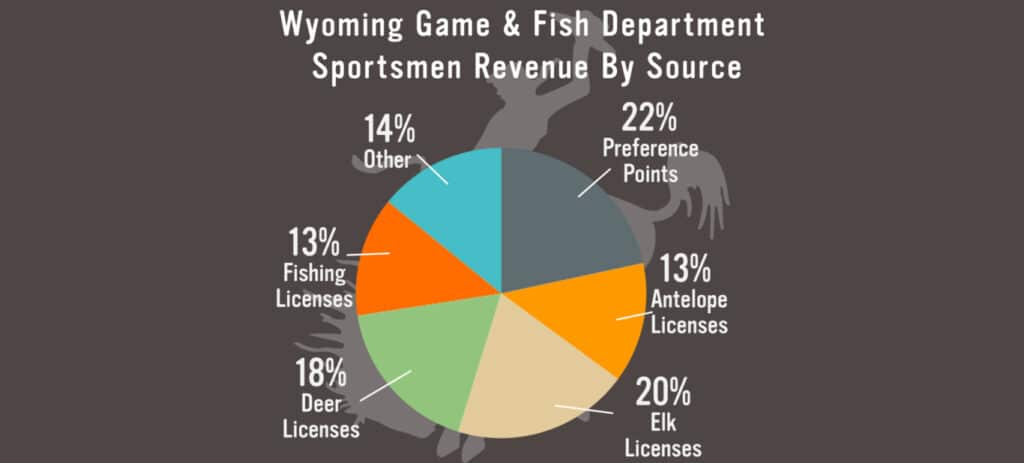By | Auna Kaufmann
Whether you say “hunting is conservation” or are frustrated by the price of a mule deer license, it is good to know where your money is going and how it impacts the management of wildlife in Wyoming. The Wyoming Game and Fish Department is funded largely by license revenue. Hunting, fishing, and trapping licenses, tag application fees, preference point sales, conservation stamps, and other fees all go into this 64% of Game and Fish’s Budget, but how exactly does all that break down, and where is it coming from?
Who is paying license fees?

Both resident and nonresident hunters, trappers, and anglers pay for different tags and licenses. Some fees are not differentiated between residents and nonresidents like conservation stamps, Super Tag sales, and watercraft registration fees, but for most licenses and tags, residents will pay significantly less than non-residents to hunt, fish, and trap in Wyoming.
An average of 80% of big game tags in Wyoming go to residents and the remaining 20% to nonresidents. In 2020, of the $56.3M generated by license revenue, $3.2M was generated by residents and nonresidents together, $9.6M was generated by residents, and $43.6M was generated by nonresident license, tag, and preference point sales. These numbers add up to more than $56.3M because the total revenue has about $785,000 subtracted for license selling agent commissions.
What species generate the most revenue?

Big game animals and fishing licenses generate the most revenue for WGFD out of all the licenses sold and fees collected. Preference points, big game tags, and fishing license sales alone make up about 86% of license revenue. The biggest earner is preference points at $12.2M – 22% of the total income.
Nonresident hunters account for 99% of preference point revenue, as nonresidents can buy preference points for deer, elk, antelope, bighorn sheep, and moose. Resident hunters only have the option to purchase preference points for bighorn sheep and moose.
After preference points, elk licenses make up the second largest proportion of license revenue at 20%. Following these licenses, deer, antelope and fishing licenses make up the next three largest revenue streams, in that order.
What projects do hunters’ dollars fund?
Hunters’ dollars from license revenue, being the largest portion of Game and Fish funding, cover many programs in WGFD’s work. Management projects for game animals and sportsmen and women like elk feedgrounds, fish stocking, public access areas, and Wildlife Habitat Management Areas (WHMA’s) are all funded, at least partially, by hunters. Revenue from Conservation Stamps, which are required for every hunter and angler in Wyoming, resident or nonresident, are split between funding hunting and fishing access opportunities (25%), a perpetual trust account funding habitat and wildlife education projects (37.5%), and the general Game and Fish fund for research, habitat improvements, and species-specific initiatives (37.5%).
You will find debates for and against various elements of this sportsmen revenue breakdown. However, as members of the public, it is important to understand the repercussions of changes to funding sources for the Wyoming Game and Fish Department. Ultimately, changes to revenue change how our wildlife are managed in the state.
